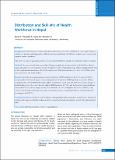Please use this identifier to cite or link to this item:
https://hdl.handle.net/20.500.14356/1845Full metadata record
| DC Field | Value | Language |
|---|---|---|
| dc.contributor.author | Bhandari, Baral B | - |
| dc.contributor.author | Prajapati, R | - |
| dc.contributor.author | Karki, K B | - |
| dc.date.accessioned | 2023-05-26T06:21:20Z | - |
| dc.date.available | 2023-05-26T06:21:20Z | - |
| dc.date.issued | 2013 | - |
| dc.identifier.citation | Baral B, Prajapati R, Karki KB,B. (2013). Distribution and Skill Mix of Health Workforce in Nepal. Journal of Nepal Health Research Council. https://doi.org/10.33314/jnhrc.v0i0.376 | en_US |
| dc.identifier.issn | Print ISSN: 1727-5482; Online ISSN: 1999-6217 | - |
| dc.identifier.uri | http://103.69.126.140:8080/handle/20.500.14356/1845 | - |
| dc.description | Special Issue Articles | en_US |
| dc.description.abstract | Abstract Background: Distribution and skill mix of health workforce has always been a challenge in rural Nepal. Workforce surpluses or shortages and inappropriate skill mix, decrease productivity and efficiency, deplete scarce resources and squander worker capabilities. This study was aimed at generating evidences on the current distribution and skill mix of health workforce in Nepal. Methods: A cross-sectional study was conducted using both qualitative and quantitative methods.Fifteen districts representing three eco-developmental regions of Nepal were selected using multi-stage cluster sampling method. Out of 404 sampled health institutions, 747 health workers from 375 health institutions were interviewed. Observation was carried out in 256 health facilities. Results: Currently, the vacant positions are mostly of doctors 74(38%) technicians 28 (21%) nurses 50 (10%) and paramedics 26 (6%)with respect to sanctioned positions. Variations of fulfilled positions occurred in all three ecological belts, with the Hill belt having the highest proportion of vacant posts 116 (16%).On the basis of types of health facilities, ayurvedic centres have the highest fulfilled positions 55 (95%) and the lowest in primary healthcare centres (PHCCs) 162 (81%). Proper skill mix was observed in 6 (43%) of hospitals and 3(18%) of PHCCs.Only 132 (17.7%) of health workers have taken part in orientation on non-communicable diseases (NCDs) despite the increasing trend of NCDs. Conclusions: There is scarcity of health workforce with appropriate skills, particularly in rural Nepal. Sanctioned positions and categories of health workers need to be revised on the basis of population growth and epidemiological shifts. | en_US |
| dc.language.iso | en | en_US |
| dc.publisher | Nepal Health Research Council | en_US |
| dc.relation.ispartofseries | Jan-April, 2013;376 | - |
| dc.title | Distribution and Skill Mix of Health Workforce in Nepal | en_US |
| dc.type | Journal Article | en_US |
| local.journal.category | Special Issue Articles | - |
| Appears in Collections: | Vol. 11 No. 2 Issue 24 May - Aug, 2013 | |
Files in This Item:
| File | Description | Size | Format | |
|---|---|---|---|---|
| 376-Article Text-400-1-10-20131127.pdf | Fulltext Download | 436.27 kB | Adobe PDF |  View/Open |
Items in DSpace are protected by copyright, with all rights reserved, unless otherwise indicated.
